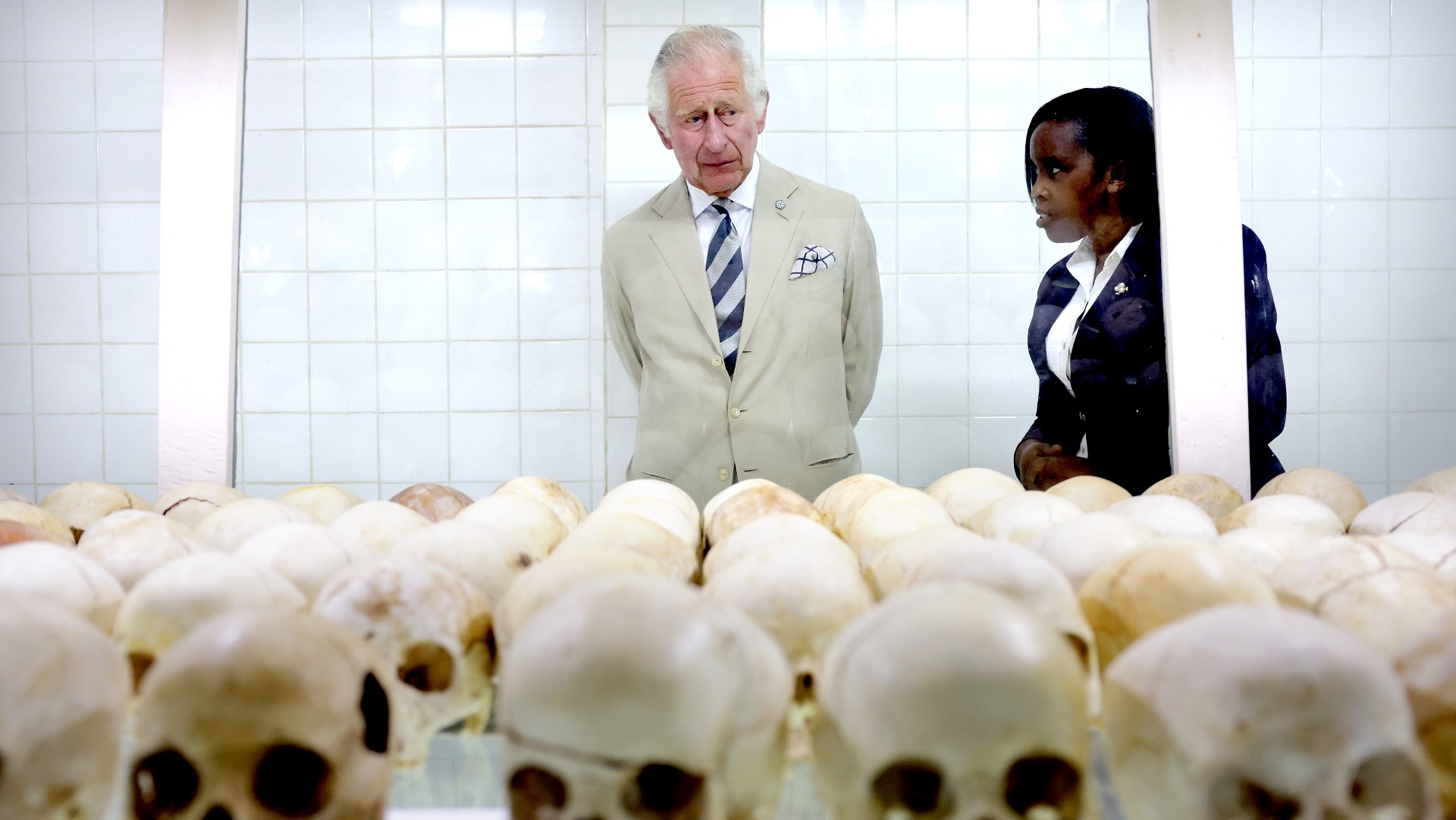Rwandan genocide: what happened in 1994?
Prince of Wales urges the world not to forget the atrocities during visit to Nyamata Church genocide memorial

Prince Charles has called on people worldwide to remember the Rwandan genocide and ensure the horrors are never repeated.
In the first visit to the African nation by a British Royal, the Prince and the Duchess of Cornwall toured key sites of the 1994 atrocity, during which up to a million people were killed.
“This must never happen again – we shall continue to remember,” Charles said during a visit to the Nyamata Church Genocide Memorial, which contains the remains of more than 45,000 people killed in the church compound and local area in just over a month.
The Week
Escape your echo chamber. Get the facts behind the news, plus analysis from multiple perspectives.

Sign up for The Week's Free Newsletters
From our morning news briefing to a weekly Good News Newsletter, get the best of The Week delivered directly to your inbox.
From our morning news briefing to a weekly Good News Newsletter, get the best of The Week delivered directly to your inbox.
“In 1994, many churches became a killing site,” wrote ITV News’ royal editor Chris Ships. At the Nyamata church, on “what were once pews in a place of prayer, there are piles of clothes from those killed here”.
And a “few steps down to the basement room below, you are confronted with row upon row of skulls”, Ship continued. The Prince of Wales “took in these sights” and “listened, mostly in silence, as he was told how these people died”.
The heir to the British throne – who is in Rwanda for a Commonwealth leaders’ summit later this week – appeared “visibly moved”, said CNN. The 73-year-old laid a wreath with a self-penned note written in the local Kinyarwanda language that said: “We will always remember the innocent souls that were killed in the Genocide Against the Tutsi in April 1994. Be strong Rwanda. Charles.”
A devastating genocide
Twenty-eight years ago, a simmering ethno-political dispute in the central African nation reached a flashpoint after decades of tension, marking the start of what is now known as the Rwandan genocide.
A free daily email with the biggest news stories of the day – and the best features from TheWeek.com
In just 100 brutal days, between 800,000 and a million Tutsi people were slaughtered by their Hutu neighbours in a devastating genocide sanctioned by the Hutu-majority government.
Up to 70% of the Tutsi population was wiped out by the killings. Most of the murders occurred within the first weeks of the genocide, in April 1994 - a period that The Guardian has called “the most momentous month in Africa's post-independence history”.
The international community was left dumbfounded by not only the scale of the genocide, but also the extreme brutality of the killers. The majority of the victims were killed by machete – a ubiquitous tool in Rwandan households. Signs of extreme torture before executions were also common.
Action on Armed Violence reported that 200,000 women were raped and “left to live with the legacies including unwanted pregnancy, HIV and Aids”.
Yet despite press around the world covering the conflict, the role of international peacekeepers in the genocide remains a highly controversial topic. The United Nations was heavily criticised for “stepping back and allowing it to happen”, in what would become a “notorious episode of abandonment”, said NPR.
By the time the bloodshed ended, hundreds of thousands had been killed, and a further two million Tutsis and Hutus had been displaced.
The tragedy remains an open wound from which Rwanda has struggled to recover. “The immensity of this tragedy sears in our minds,” said anti-genocide charity The Sentinel Project.
“We must move beyond scale and statistics, and grasp that each life lost represents a family, a community, a nation changed forever,” the charity added.
How did it start?
The roots of the ethnic conflict between the Hutus and the Tutsis can be traced back to colonial rule. The Belgian occupiers openly favoured the minority Tutsis over the Hutus, placing them in positions of power.
This caused resentment to fester and played a role in the so-called Hutu Peasant Revolution in 1959, which forced hundreds of thousands of Tutsis into exile and handed political control to the majority Hutus.
On 6 April 1994, a plane carrying Rwandan President Juvenal Habyarimana was shot down, resulting in his death. The Hutu government claimed that the Tutsi-led Rwandese Patriotic Front (RPF) was behind the attack, while others accused Hutu extremists of attempting to thwart an imminent peace deal.
The Huti armed forces used the president’s death as an excuse to attempt to eliminate the Tutsis. Within an hour of the plane crash, government soldiers, alongside the infamous Interahamwe Hutu militia, began their horrifying campaign.
What happened?
The killings began in the capital but quickly spread across the country, with militiamen on radio stations encouraging Hutu civilians to rise up and “weed out the cockroaches”.
Roadblocks were set up by militias, and Hutu citizens armed with machetes went from village to village, door to door, torturing and murdering Tutsi men, women and children.
Neighbours killed neighbours, and husbands were forced to kill their Tutsi wives. “Even priests and nuns have been convicted of killing people, including some who sought shelter in churches,” said the BBC.
Meanwhile, the RPF continued fighting the Hutu army and militias, and slowly began taking back control of parts of the country.
Within just 100 days of conflict, upwards of 800,000 Tutsis were murdered.
Some 100,000 Hutus were also killed, some by the RPF, others by fellow Hutus for protecting or sympathising with the Tutsis.
How did it end?
The RPF, backed by the Ugandan army, finally regained control of the country in early July, bringing an end to the mass killings. The Hutu government and militias fled to the Democratic Republic of the Congo (then Zaire), along with two million Hutu civilians.
The International Criminal Tribunal for Rwanda (ICTR) was established in Tanzania that November, with trials against those responsible for the genocide beginning the following year. But many of them remain at large in the DRC.
Did anyone help the Tutsis?
The international community faced widespread condemnation for failing to try to prevent the slaughter.
“Unlike earlier mass killings, such as the Holocaust, the international community had advance evidence of the coming genocide,” said Vox.
The UN was warned by one of its generals in January 1994 that Hutus were planning a massacre.
“Once it launched, they had evidence of where it was going, and still did nothing,” the website added. “The United States actively discouraged the UN Security Council from authorising a more robust deployment.”
Four years after the genocide, then US president Bill Clinton and UN secretary general Kofi Annan both apologised to the victims for not attempting to prevent the atrocities that took place.
The international community “must bear its share of responsibility for this tragedy”, Clinton said. “We did not immediately call these crimes by their rightful name: genocide.”
Speaking to the Rwandan Parliament, Annan said: “We will not deny that, in their greatest hour of need, the world failed the people of Rwanda.”
-
 Which side is JD Vance taking in MAGA’s infighting?
Which side is JD Vance taking in MAGA’s infighting?Today’s Big Question GOP insiders are battling over antisemitism with an eye on 2028
-
 Campus security is in the public eye again after the Brown shooting
Campus security is in the public eye again after the Brown shootingTalking Points Questions surround a federal law called the Clery Act
-
 9 new cookbooks begging to be put to good winter use
9 new cookbooks begging to be put to good winter usethe week recommends Booze-free drinks, the magic versatility of breadcrumbs and Japanese one-pot cooking
-
 How Bulgaria’s government fell amid mass protests
How Bulgaria’s government fell amid mass protestsThe Explainer The country’s prime minister resigned as part of the fallout
-
 Femicide: Italy’s newest crime
Femicide: Italy’s newest crimeThe Explainer Landmark law to criminalise murder of a woman as an ‘act of hatred’ or ‘subjugation’ but critics say Italy is still deeply patriarchal
-
 Brazil’s Bolsonaro behind bars after appeals run out
Brazil’s Bolsonaro behind bars after appeals run outSpeed Read He will serve 27 years in prison
-
 Americans traveling abroad face renewed criticism in the Trump era
Americans traveling abroad face renewed criticism in the Trump eraThe Explainer Some of Trump’s behavior has Americans being questioned
-
 UN Security Council backs Trump’s Gaza peace plan
UN Security Council backs Trump’s Gaza peace planSpeed Read The United Nations voted 13-0 to endorse President Donald Trump’s 20-point plan to withdraw Israeli troops from Gaza
-
 Cop30: is the UN climate summit over before it begins?
Cop30: is the UN climate summit over before it begins?Today’s Big Question Trump administration will not send any high-level representatives, while most nations failed to submit updated plans for cutting greenhouse gas emissions
-
 Nigeria confused by Trump invasion threat
Nigeria confused by Trump invasion threatSpeed Read Trump has claimed the country is persecuting Christians
-
 ‘Never more precarious’: the UN turns 80
‘Never more precarious’: the UN turns 80The Explainer It’s an unhappy birthday for the United Nations, which enters its ninth decade in crisis